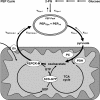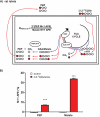Phosphoenolpyruvate cycling via mitochondrial phosphoenolpyruvate carboxykinase links anaplerosis and mitochondrial GTP with insulin secretion
- PMID: 19635791
- PMCID: PMC2785346
- DOI: 10.1074/jbc.M109.011775
Phosphoenolpyruvate cycling via mitochondrial phosphoenolpyruvate carboxykinase links anaplerosis and mitochondrial GTP with insulin secretion
Abstract
Pancreatic beta-cells couple the oxidation of glucose to the secretion of insulin. Apart from the canonical K(ATP)-dependent glucose-stimulated insulin secretion (GSIS), there are important K(ATP)-independent mechanisms involving both anaplerosis and mitochondrial GTP (mtGTP). How mtGTP that is trapped within the mitochondrial matrix regulates the cytosolic calcium increases that drive GSIS remains a mystery. Here we have investigated whether the mitochondrial isoform of phosphoenolpyruvate carboxykinase (PEPCK-M) is the GTPase linking hydrolysis of mtGTP made by succinyl-CoA synthetase (SCS-GTP) to an anaplerotic pathway producing phosphoenolpyruvate (PEP). Although cytosolic PEPCK (PEPCK-C) is absent, PEPCK-M message and protein were detected in INS-1 832/13 cells, rat islets, and mouse islets. PEPCK enzymatic activity is half that of primary hepatocytes and is localized exclusively to the mitochondria. Novel (13)C-labeling strategies in INS-1 832/13 cells and islets measured substantial contribution of PEPCK-M to the synthesis of PEP. As high as 30% of PEP in INS-1 832/13 cells and 41% of PEP in rat islets came from PEPCK-M. The contribution of PEPCK-M to overall PEP synthesis more than tripled with glucose stimulation. Silencing the PEPCK-M gene completely inhibited GSIS underscoring its central role in mitochondrial metabolism-mediated insulin secretion. Given that mtGTP synthesized by SCS-GTP is an indicator of TCA flux that is crucial for GSIS, PEPCK-M is a strong candidate to link mtGTP synthesis with insulin release through anaplerotic PEP cycling.
Figures






References
-
- Newgard C. B., Lu D., Jensen M. V., Schissler J., Boucher A., Burgess S., Sherry A. D. (2002) Diabetes 51, S389–393 - PubMed
-
- Pongratz R. L., Kibbey R. G., Shulman G. I., Cline G. W. (2007) J. Biol. Chem. 282, 200–207 - PubMed
-
- Cline G. W., Lepine R. L., Papas K. K., Kibbey R. G., Shulman G. I. (2004) J. Biol. Chem. 279, 44370–44375 - PubMed
Publication types
MeSH terms
Substances
Grants and funding
- HHMI/Howard Hughes Medical Institute/United States
- U24 DK059635/DK/NIDDK NIH HHS/United States
- P30 DK-45735/DK/NIDDK NIH HHS/United States
- R01 DK040936/DK/NIDDK NIH HHS/United States
- P30 DK045735/DK/NIDDK NIH HHS/United States
- R01 DK-71071/DK/NIDDK NIH HHS/United States
- K08 DK-80142/DK/NIDDK NIH HHS/United States
- K08 DK080142/DK/NIDDK NIH HHS/United States
- P30 DK-34989/DK/NIDDK NIH HHS/United States
- P30 DK034989/DK/NIDDK NIH HHS/United States
- R01DK-40936/DK/NIDDK NIH HHS/United States
- R01 DK071071/DK/NIDDK NIH HHS/United States
LinkOut - more resources
Full Text Sources
Other Literature Sources
Medical
Molecular Biology Databases
Research Materials
Miscellaneous

